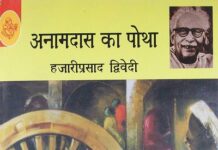
Volga Se Ganga by Rahul Sankrityayan is an epic. It traces the human evolution from 6000 BCE to 1942 CE through a common man’s eyes. It begins on the banks of Volga River when the man was a hunter-gatherer. Through small stories from various eras, its tracks our evolution through various eras. Though towards the second half it concentrates on the Indian sub-continent, it never loses view of the rest of the world. In fact, after reading the book, I felt India or rather world was always as globalized as it is now.
The book talks at various levels. Through the dialogues of the common citizens, it presents an assessment of the life and time in those eras. In the early days, it shows how matriarchal societies lived on meat and water. How the only parent people knew of was the mother, so the lineage ran from mother to daughter. The daughters had a similar relationship with their mothers that medieval kings had with their sons. They fought for inheritance. Slowly the farming entered man’s life.
However, what left a bigger impression on me was the advent of metals – first iron and then gold. Rahul Sankrityayan portrays how the metals started dividing man into communities. How it started adding hierarchy based on who possessed how much of these metal pieces. The arguments between various characters in the stories will give you a sense of Deja Vu. We have heard similar arguments when the TV came or when computers came and when mobile phones came. Reading this book told me that all these big changes will eventually become a part of our lives in a way that we would not even remember that they caused a disruption. Probably every significant era in the history was nothing but a collection of big disruptions.
First few chapters of Volga Se Ganga that trace pre-historic history must have made Rahul Sankrityayan imagine a lot. Later chapters are based on available literature and the last chapters seem to be coming from the first-hand experience of the author. You see a clear inclination towards socialism as was the flavor of the era. You also get a counter view of what people thought of Gandhi & Ambedkar. Given that this book was written before independence you have no reason to doubt those opinions. The fact that a common man in Patna hated being called a Harijan Gandhi or they disliked Ambedkar as much is something pundits of today may find difficult to digest.
I loved the whole of Volga Se Ganga but one of the chapters that stand out is based in Ujjain during the reign of Harshvardhan. The story tells the times from the perspective of a king, his court poet, and one more person. It brings out the role of court poets who would paint the king as an ideal ruler – handsome, brave, kind and just. They would create their palaces and personas more from their imagination than from reality. Now you wonder if you should admire the poet or his subject or do not trust either.
There is a description of the evolution of human relationships. It begins with nomadic tribes where man and woman only each other sexually and the only other relationship they understand is mother & children. It evolves to a family when farming becomes the main occupation and the man stops wandering. Slowly the romance begins to appear in his stories and it stays there. He has not touched upon deceit in relationships. He has explored relationships between communities, between opponents, between friends, and between families.
What makes this book special is that it skips all the important events that we know from our history books. So it does not talk about the rise of Buddha & Buddhism, though there are arguments that talk about tenets of Buddhism. Similarly, there is no mention of invasions except how it impacted the common man. Even Gandhi & Ambedkar make the appearance as talking points between people and none of their often mentioned personalities or achievements are talked about. No big events cloud the stories and you get a feel of the lifelike yours in different eras.
I read this book in Hindi though it is available in multiple languages. If you are also planning to read it in Hindi, you need to have a good grip on Hindi. He uses certain local words that you have to guess. There is an occasional English word as well.
If you are a travel writer like me, you would have a lot to learn from this book. This book is a lovely example of how to convert a history lesson into a beautiful story that makes sense to everyone. It tells you a lot but in a way that you take it all effortlessly. The language is engaging and narrative gripping.
I think Khushwant Singh wrote his novel Delhi using the same format of writing when he told the story of Delhi through the eyes of a commoner.
I am looking forward to reading other books of Rahul Sankrityayan – there are two more in my library.
Go, read it.









life histories and philosophies through the eyes and mind of a travelogue writer was very interstin 2 read.
It is very interesting Dr Karthik.
I am very much interested in reading this one; not in Hindi though as that much of a grip is not there – but surely makes it to my list of works to read.
Tennyson, this book thankfully is available in English as well as many other Indian languages.
You are serving Hindi literature significantly by reviewing some of its better works in English. It is indeed a pity that most of our youngsters are completely unaware of great writing in Hindi and other Indian languages. Hope your reviews will divert them from the current crop of pulp fiction and open the gates to iconic Indian writing.
I hope to Rajiv ji.